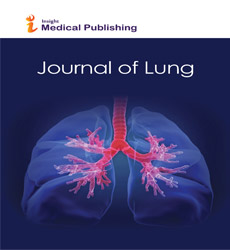Overview on Lung Cancer
Xuemei John*
1Department of Biomedical Data Science, Geisel School of Medicine, Hanover, USA
- *Corresponding Author:
- Xuemei John Department of Biomedical Data Science, Geisel School of Medicine, Hanover, USA, E-mail: xuemei.ji@12yahoo.com
Received Date: August 03, 2021; Accepted Date: August 18, 2021; Published Date: August 26, 2021
Citation: John X (2021) Overview on Lung Cancer. J Lung Vol.2 No.4:10.
Description
Cancers with huge, abnormal-looking cells are known as large cell carcinomas. These tumours can start anywhere in the lungs and spread rapidly. The majority of lung cancers are carcinomas, which are malignant lung tumours marked by uncontrolled cell proliferation in lung tissues. Lung cancer also is termed as lung carcinoma for this reason. Lung carcinomas arise from epithelial cells that have been converted into malignant cells, or from tissues made up of epithelial cells. Other lung cancers, such as uncommon lung sarcomas, are caused by the malignant transformation of connective tissues that emerge from mesenchymal cells. The vast numbers of lung cancer cases are caused by long-term tobacco use. People, who have never smoked, record in 10–15 per cent of instances. A combination of genetic factors plus exposure to radon gas, asbestos, second-hand smoke, or other forms of air pollution are frequently responsible for these cases. Coughing, coughing up blood, wheezing, or shortness of breath, are some of respiratory symptoms. Weight loss, weakness, fever, or clubbing of the fingernails, are the systematic symptoms that include in lung cancer. If the cancer spreads to the airways, it may impede airflow, making it harder to breathe. The obstruction can also cause secretions to build up behind the blockage, raising the risk of pneumonia.
Many of the signs and symptoms of lung cancer such as loss of appetite, weight loss, fever, and exhaustion are vague. By the time they notice symptoms and seek medical help, many people's cancer has already progressed beyond the original spot. Weight loss, bone pain, and neurological symptoms all indicate the existence of metastatic illness; a cancer spreads to a different section of the body from where it began. The brain, bone, adrenal glands, opposite lung, liver, pericardium, and kidneys are all common sites of spread. About 10% of persons with lung cancer have no symptoms when they are diagnosed; these tumours are discovered by chance during routine chest radiography. Cancer arises as a result of genetic damage to DNA and epigenetic alterations, which is the main cause of lung cancer. The cell's usual processes, such as cell proliferation, programmed cell death, and DNA repair, are all affected by these alterations. The risk of cancer grows as more harm is done.
Lung cancers that are discovered directly in the lungs are the most common. In the lungs and chest wall, other, less common cancers can develop. The most appropriate approach of prevention is to minimise risk factors such as smoking and air pollution. The type of cancer, the stage, and the person's overall condition all influence treatment and long-term prognosis. The majority of cases are incurable. Surgery, chemotherapy, and radiotherapy are all common therapies. Chest radiography and Computed Tomography (CT) scans can reveal the presence of lung cancer. Biopsy, which is commonly done under bronchoscopy or CT guidance, is used to confirm the diagnosis. We need to check lung nodule which is a tiny abnormal spot that is discovered on a chest CT scan. Specific frequencies for pulmonary nodule surveillance are recommended in clinical practise recommendations. CT imaging should not be used for any longer or more frequently than the clinical recommendations recommend, as any further surveillance exposes people to more radiation and is expensive.
Open Access Journals
- Aquaculture & Veterinary Science
- Chemistry & Chemical Sciences
- Clinical Sciences
- Engineering
- General Science
- Genetics & Molecular Biology
- Health Care & Nursing
- Immunology & Microbiology
- Materials Science
- Mathematics & Physics
- Medical Sciences
- Neurology & Psychiatry
- Oncology & Cancer Science
- Pharmaceutical Sciences
